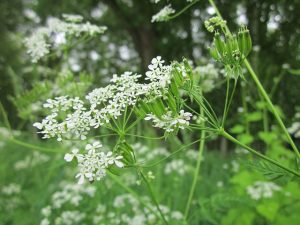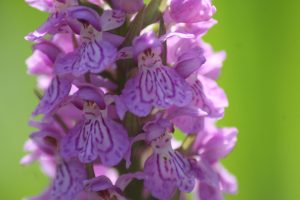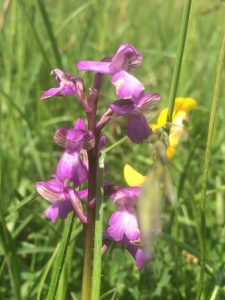By Andy Winfield
There’s something about May. It’s an incredibly uplifting month, particularly when there’s been a longer than usual winter; a very wet march and an icy easterly wind has kept the dregs of winter sloshing around up until the end of April. The sun’s position in the sky meant that the usual spring triggers applied for the likes of primroses, daffodils and tulips, but the temperature and wet weather meant that pollinators were out in dribs and drabs, a day on and a day off. Even my usually optimistic approach wavered and my bottom lip stuck out. But now the temperature is higher, Bristol is bright green again and plants are assertively growing from everywhere.

During my walk to the Botanic Garden at the moment, there’s a tangible feeling of life in the air and below my feet; the phrase ‘full of the joys of spring’ seems perfect for now. At 7 am as I head to work, birds are noisy and the sun skims the flowers of cow parsley in my local park. The cow parsley grows in an area that has been left unmown for about three years; it slopes up from a line of London plane trees that are enormous, probably around 150 years old. Watching the seasonal progression of this space every day as I walk to work has been lovely, only a few weeks ago it was covered in constellations of celandine. Under the branches of the planes hawthorn, elder, and the odd holly saplings are growing, planted indiscriminately by roosting birds; and among them the native stinking iris (also known as the roast beef plant due to the smell of its leaves), nettles, and currently the fleeting flowering of cow parsley.
In the Botanic Garden we have a similar area with an identical slope, (although we’ve taken out any bird sown seeds so we can leave it as a meadow); it too had a period of nettles and cow parsley which together are a sign of a soil high in nitrogen. These don’t appear there anymore, so they must have removed what they needed from the ground and moved on. The high feeders have been replaced by pignut, creeping buttercup, ground ivy, and yellow rattle. It’s still early days for this experimental area, but last year common spotted orchid popped up, which bodes well for other orchid species in the future to make this patch their own.
 Orchids are a particular favourite of mine. If you see one growing out in woods or meadows, take a moment to think of that plant’s journey to where they are now. Orchid seed is incredibly light as it doesn’t have stored food to get the seedling started like other plants, it needs to rely on the right kind of fungi to give it sustenance, in return the fungi will get moisture and access to organic matter. As the seed is so weightless, a plant can produce millions of seed which can travel long distances on the wind; so when you see an orchid, it could be the one seed in a million that has landed at the exact spot with the perfect conditions and the right fungi for it to grow.
Orchids are a particular favourite of mine. If you see one growing out in woods or meadows, take a moment to think of that plant’s journey to where they are now. Orchid seed is incredibly light as it doesn’t have stored food to get the seedling started like other plants, it needs to rely on the right kind of fungi to give it sustenance, in return the fungi will get moisture and access to organic matter. As the seed is so weightless, a plant can produce millions of seed which can travel long distances on the wind; so when you see an orchid, it could be the one seed in a million that has landed at the exact spot with the perfect conditions and the right fungi for it to grow.

The succession of heavy feeder plants to terrestrial orchids makes a lot of sense; most terrestrial orchids won’t grow in a nutrient rich soil, and here in Bristol orchid species can be found on the thinnest covering of soil on top of our limestone bedrock. In Ashton Court Estate about now (mid May) are hundreds of green winged orchids in the unmown grasslands; this area of the city is a delight, with skylarks singing from their lofty hover, and butterflies and bees finding what they need in the meadows. If you want an example of what can happen when you just leave an area to nature, have a look up there. I’m looking forward to seeing what plants arrive in my local park after the cow parsley has had its fill.


1 thought on “Seasonal succession.”